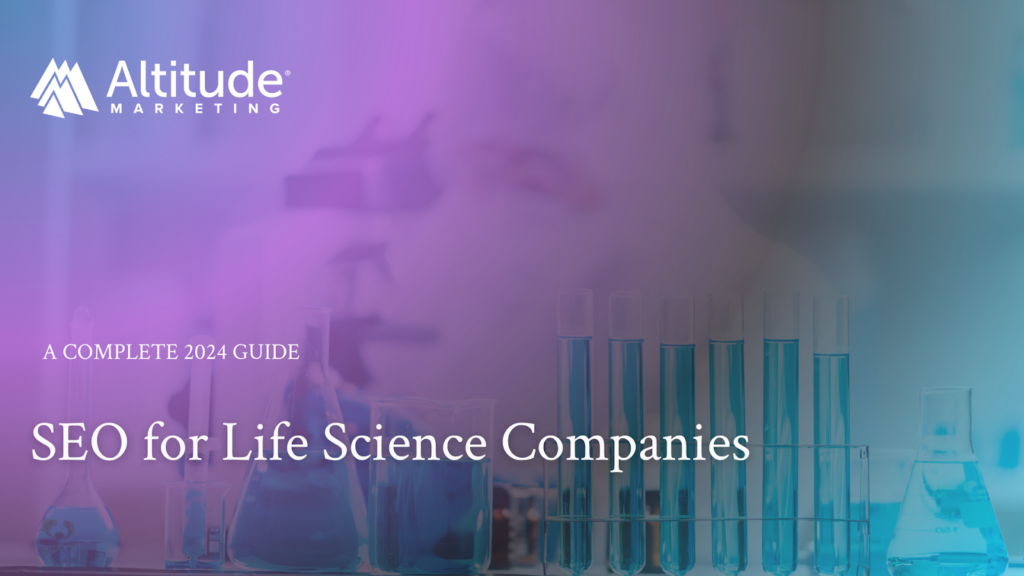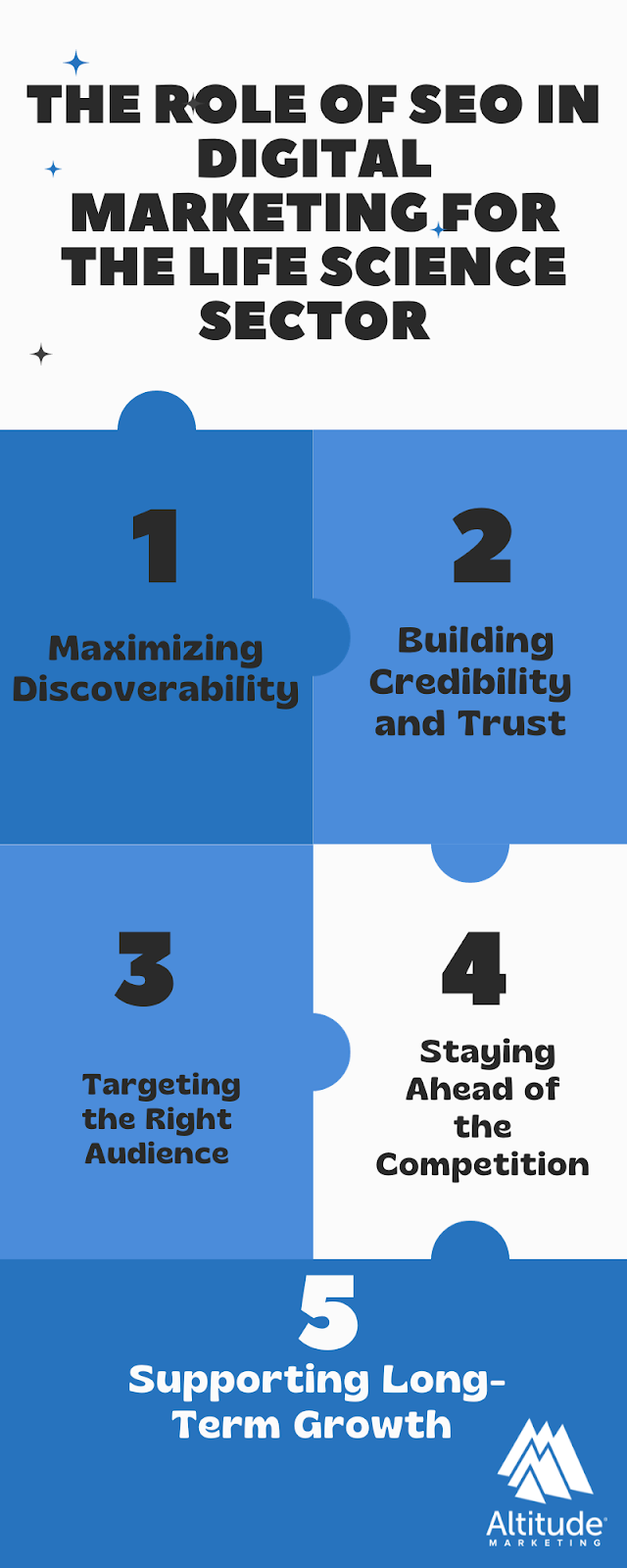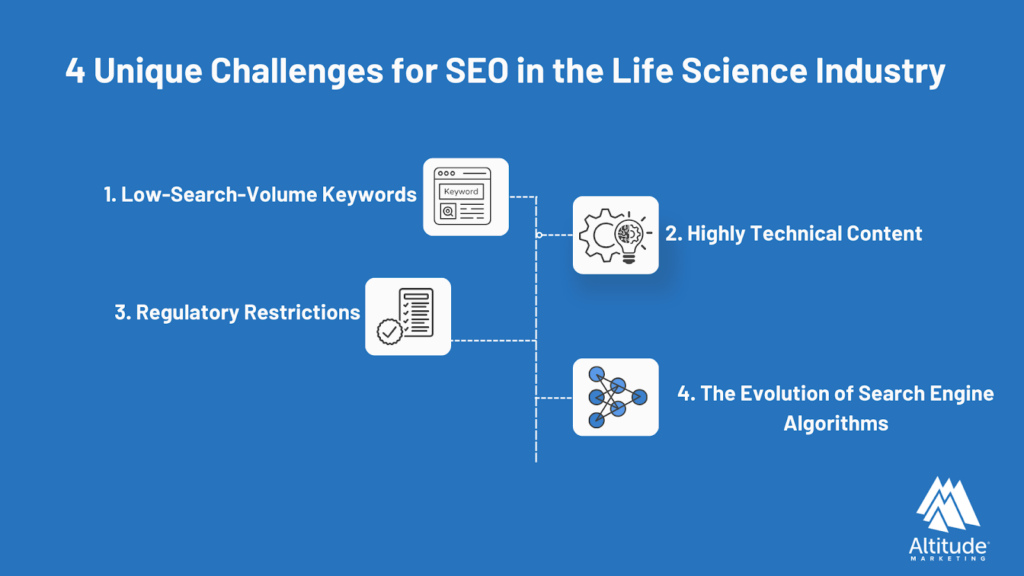As the online world evolves, so do the ways companies reach people. SEO (search engine optimization) is fundamental to that conversation. High-ranking, useful content that comes directly from your B2B life sciences brand can be one of the most effective marketing investments you can make.
SEO is crucial for marketing. It won’t just boost website traffic. It brings qualified leads directly to you, organically. That means your audience is starting from a level of trust that doesn’t exist through paid advertising tactics. But good SEO requires work and time. In this post, we’ll examine 2024 SEO trends and best practices that can help life sciences B2B companies target–and ultimately capture–a valuable audience.

Overview
Why SEO is Crucial for B2B Life Sciences Companies
SEO accomplishes one simple (yet invaluable) mission: Boosting visibility to your key digital audience. By optimizing websites and content for keywords and search queries, brands can establish credibility and authority in their field. In the life sciences, an industry based on authority and trust, that earned recognition means more traffic, leads, and revenue. Here are 5 ways SEO can boost your digital marketing strategy:

1. Maximizing Discoverability
The life sciences field is bursting with innovation and discoveries. But if your target audience can’t find your work, your accomplishments won’t be recognized.
The use of SEO ensures that your website and content show up in search engine results. This allows you to be discovered by researchers, professionals, investors, and customers looking for information in your niche.
2. Building Credibility and Trust
Credibility is key in the life sciences industry. That’s because prospective clients, collaborators, and investors need to trust your expertise and knowledge. A well-optimized website that ranks high in search results shows expertise and authority.
By consistently producing quality and SEO-friendly content, you position your brand as a thought leader. This serves to foster trust and respect within the industry.
3. Targeting the Right Audience
Effective SEO involves identifying the right keywords and phrases that your audience might be searching for. Targeting your content to address their queries enables you to attract the right people to your site.
A targeted approach helps to ensure that your resources and offerings reach the people who are genuinely interested in them. This leads to higher engagement levels and conversion rates.
4. Staying Ahead of the Competition
The life sciences industry is very competitive, and as such, you must stay ahead of the competition. Implementing SEO strategies ensures that you keep your eyes on what the competition is doing, which helps you to adapt.
To keep abreast of their tactics, you must monitor their keywords, content strategies, and online tactics. This will give you the insights you need to form your brand’s strategy, helping you differentiate yourself and stay at the forefront.
5. Supporting Long-Term Growth
Keep in mind that investing in SEO is not a short-term fix. It builds a foundation for steady, organic growth. By consistently optimizing your online presence, you create a sustaining cycle of visibility and conversion.
As your content gains traction, your website’s authority also grows, resulting in improved search rankings. It also leads to increased traffic and long-term success, which, in turn, helps your content gain traction. Every tactic builds on itself. But this takes time and consistent effort.
6 SEO Strategies to Boost the Visibility of Your Life Science Website
Now that you understand why SEO is valuable, here’s how to implement it properly.
| SEO Strategy | Impact |
| 1. Creating high-quality, informative content | Increases organic traffic and builds brand authority. |
| 2. Building backlinks from relevant sites | Improves domain authority and rankings. |
| 3. Optimizing website for user experience | Boosts engagement metrics and lower bounce rate. |
| 4. Targeting keywords | Target the right audience with industry-specific phrases. |
| 5. Avoiding excessive jargon | Makes content more readable and engaging. |
| 6. Matching keyword intent | Better meet searcher needs, and improve click-through rate. |
1. Create Quality Content
Content is king in SEO. Google’s algorithm values information that is accurate, informative, engaging, and provides value. In order to rank, your content must include research findings, product information, educational resources, and industry news. Above all else, it must be useful to the reaer
Apart from attracting visitors, quality content also encourages them to stay longer on your website and explore. This helps to minimize bounce rates and increase your website’s chances of ranking higher in search results.
2. Build a Quality Backlink Network
Backlinks are critical to helping you rank. They are links that another website places in their content, which point back to your site. Backlinks signal to search engines that your content is valuable and trustworthy. The more backlinks you have, the higher the chances that your website will rank higher.
Earning backlinks can be difficult. It requires action from a network outside of your organization. However, there are several strategies that you can use to make it possible. These include guest blogging, creating networks, and building relationships with influencers. But, you must also note that the quality of the backlinks is more important than their quantity in your content. Links from reputable and high-authority sites in the life science sector carry more weight.
3. Design Your Site With the User in Mind
Search engines favor websites that provide a good user experience. This includes fast loading times, easy navigation, and a mobile-friendly layout.
Remember that information in the life sciences industry can be complex and dense. Thus, a good user experience will be necessary to make your content more accessible and understandable. You must ensure that you have headings and subheadings. Break up text with images and bullet points, and use interactive elements like videos.
4. Leverage Industry Keywords
Targeting industry-specific keywords is crucial for the success of B2B SEO. By integrating keywords that include niche phrases related to your industry, you can attract relevant traffic to your site. To identify and target keywords, you can:
- Use keyword research tools: Utilize tools like Google Ads Keyword Planner and SEMrush to find keywords and their search volume.
- Analyze industry reports and competitors: Industry reports and competitor websites can provide insights into common local keywords and trends.
- Monitor keyword performance: Regularly assess the performance of your targeted keywords, adjusting your strategy as required.
5. Avoid Acronyms and Jargon
Acronyms and jargon are common in the life sciences industry. However, they can be confusing, which may put off a section of your audience. So, try to limit the use of industry-specific acronyms when creating your content. In cases where you have to use them, make sure that you explain what they mean.
Rather than oversimplify, aim for a balance between being accessible to a broad audience and providing in-depth content that experts in the field will appreciate. This approach will make your website more appealing, hence increasing your chances of ranking high in search results.
6. Match Keyword Intent
Brands must match the intent behind their keywords. This means understanding why your audience is searching for a certain term and ensuring that you meet their needs.
Note that there are three main types of search intent: 1) Informational, where the user wants to learn something; 2) Transactional, where the user wants to make a purchase; and 3) Navigational, for those who want to go to a specific website. Understanding these intents will help you tailor your content to meet the needs of your audience.
4 Unique Challenges for SEO in the Life Sciences
The life sciences industry faces unique challenges when it comes to SEO. One of the biggest is the highly technical nature of the content. This makes it difficult for non-experts to create content that’s both informative and engaging. The good news: This means even simple SEO steps can give you a leg up on your competition. Here are 4 common challenges and how to address them.

1. Low-Search-Volume Keywords
Your niche might involve keywords that many people are not searching for. But they are still valuable because the right people are searching for them. These “long-tail” niche keywords attract highly targeted visitors. Optimize website pages and content for low-competition long-tail keywords to improve search visibility.
2. Highly Technical Content
Simplify complex technical life sciences topics using clear explanatory language, analogies, and examples to make the content accessible. Use visuals like charts and summaries to help readers understand the technical sections and key takeaways.
3. Regulatory Restrictions
Vet all life sciences content through legal and regulatory teams before publishing to ensure compliance with regulations. Focus on creating educational life sciences content rather than overtly promotional content to provide value to readers.
4. Changing Algorithms
Algorithms might change, but one thing doesn’t. They will always value authoritative, useful work. Conduct regular audits to identify any issues negatively impacting SEO performance. Focus on creating high-quality, useful life sciences content that solves user intent and provides value to stay ahead of algorithm changes.
The Future of SEO in the Life Sciences
Moving into 2024 and beyond, make sure you have an agile SEO strategy that incorporates these three trends:
1. Increased focus on buyer experience: There has been a shift towards more personalized, tailored buyer interactions to ensure the delivery of up-to-date and audience-specific content.
2. Voice optimization: The growing prevalence of voice search necessitates optimizing web content for voice queries, which involves integrating natural language processing and focusing on conversational, industry-relevant keywords to ensure accessibility in a voice-first world.
3. Greater use of data and analytics: By leveraging data and analytics, life science brands can gain valuable insights into their target audience, optimize their SEO strategies, and measure the ROI of their marketing efforts.
FAQ's
1. How can life sciences companies select the right keywords to target?
Research keyword demand using tools like Google Keyword Planner. Focus on long-tail keywords specific to your products/services with decent search volume. Then, analyze competitors’ keywords and optimize pages for terms they may be missing.
2. What type of content works best for SEO in the life sciences industry?
- In-depth, comprehensive guides and eBooks work well to establish thought leadership.
- Educational written content like blogs and articles optimized with keywords.
- Interactive content like quizzes, surveys, and assessments to boost engagement.
- Visual content and videos tend to perform well and can simplify complex topics.
3. How should life sciences companies promote their research, products and services for better SEO?
- Optimize landing pages for keywords related to the product or service.
- Publish press releases about new breakthroughs for pickup by industry media outlets.
- Share new updates on social media channels and link back to your site.
Conclusion
SEO is powerful when done right. It brings the right audience straight to you, with no paid advertising spend.
It takes effort to master, but pays off in brand recognition, trust and authority. That’s why it needs to be top-of-mind in any life sciences B2B digital strategy.




